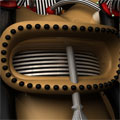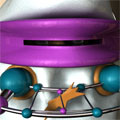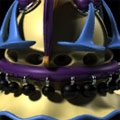Synopsis
Information
“The
Realm of Possibility”
is a digital animation begun in May of 2008 and completed in January of
2009. Instead of creating “story boards,” I chose to let the
narrative of the work intuitively unfold as part of the creative process.
Computer animation is time consuming and since I am working on my own, I
have the luxury of constant revision.
My initial concept for the piece began with the vague notion that a hand
printed lithograph, or chromolithograph, could be visually rich
when drastically increased in scale. Unlike printing today which uses photographic
dot patterns to separate colors, prints from the early part of the twentieth
century were hand drawn directly onto the printing surface, usually a limestone.
When viewed closely, each stroke of the artist’s pencil in this type
of printing is rendered in pure color. When enlarged, the overall effect
becomes abstracted, almost resembling an Impressionist painting.
I used Ebay as a source to hunt for old chromolithographs and successfully
bid on an early 1900’s French game board print that had never been
adhered to its backing. This print became the ideal backdrop for a narrative
that, besides being beautifully rendered, incorporated a linear sequencing
of numbers presumably for the movement of game pieces or men. The print
also depicted charming vignettes of early aviation adventures, featuring
a Curtiss “Jenny” biplane.
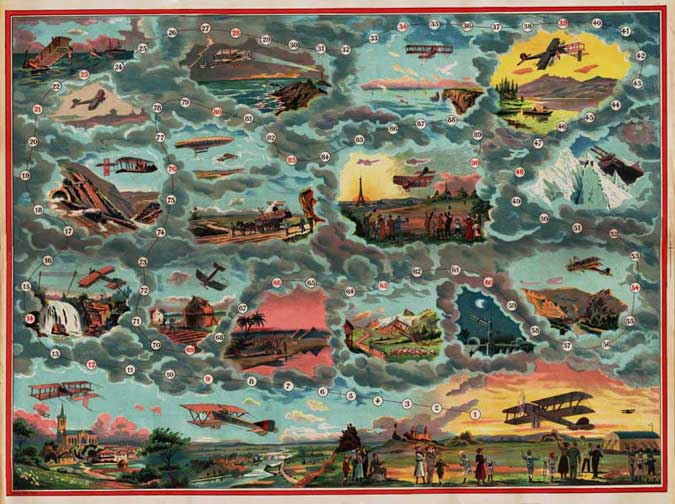
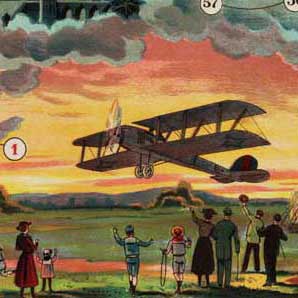
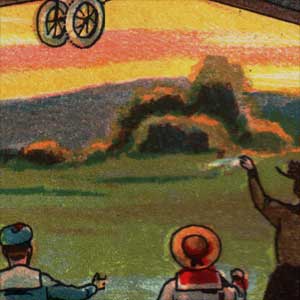
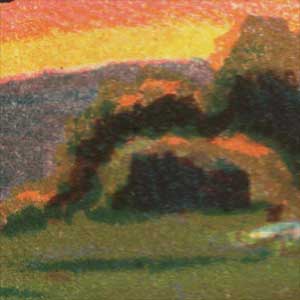
This happenstance led to research about that model of airplane and the subsequent
inclusion of Jenny biplanes as part of the overall narrative. I scoured
the Internet for visual examples and attempted to be as accurate as possible
in modeling the proportions and details of the plane. I find personal satisfaction
in becoming acquainted with a subject, even with the understanding that
certain subtleties may never be observed. I use to model the screws in the
hinges of doors that were not open, but thankfully have moved past that
obsession.
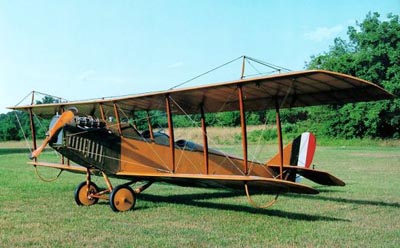
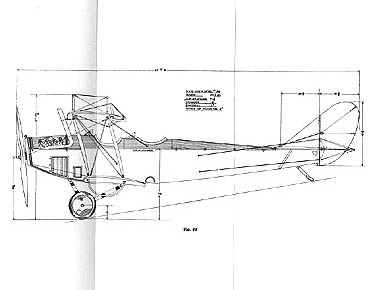
I have been engaged with the spirit of interior space my entire career.
The challenge of recreating an old library had been in the back of my mind
so I took photographs of several old libraries here on the University of
Illinois campus, most notably The Ricker Library of Art and Architecture
and the Mathematics Library in Altgeld Hall. These images served as a visual
guide and became usable texture maps in the final scene. The architecture
of these spaces was blended into an “ideal” library, including
doomed card catalogs. It’s possible, and unnerving, that books to
may also become relics of the past.
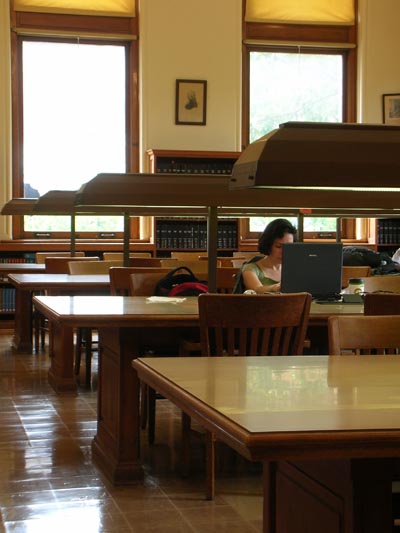
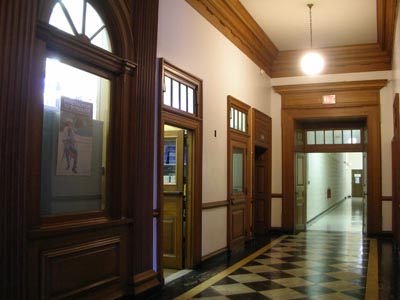
With most of the visual aspects in place, the next goal was to define a
concept and acquire dialogue. I often use public domain material, enjoying
the notion of revisiting or “recycling” dated information. My
searches led me to an excellent web resource called “Lit2Go,”
a service of Florida’s Educational Technology Clearinghouse. Here
I found the work “Symbollic Logic” by Lewis Carroll, narrated
by volunteer Rick Kistner. The premise of the work concerns syllogisms and
deductive reasoning (a is b, b is c,
therefore a is c). I especially enjoyed the humor of an
idea being more logical on a planet other than our own. In a more serious
sense, deductive reasoning is a potentially malleable concept that can be
used irresponsibly.
Another goal was to incorporate the human form. In past work, my prints
and drawings most often featured a suited “everyman” as a sort
of psychological insertion point for vicarious viewer involvement. More
recently, I shied away from characters in my animations, hoping to imply
human presence through the use of symbols or virtual “stand ins.”
Part of this reluctance is based on the fact that it is difficult to get
past the CG “look” of 3D figures. My solution was to use a mask
to hide the face of the character, the most difficult aspect to believably
simulate. I don’t claim to be an expert character animator, instead
rely on artistic devices in order to avoid that which is beyond my technical
expertise. Necessity is the mother of most invention.
Instead of building the character from scratch, I purchased a rigged model
online and spent quite a bit of time altering and refining the figure to
fit my needs. I also purchased some motion capture files that made realistic
movement more feasible. There is still a lot to learn about character animation
and these are the first steps, literally.
One of the quicker but especially enjoyable aspects of the project was the
sound and video editing. Adding incidental sounds, such as footsteps or
chair squeaks, is the magic ingredient that brings visuals to life. All
of these sounds were downloaded from the web. I also wanted an ethereal
sound to help carry the viewer from one figure to the next during the “print
walk.” I started with a royalty free ambient sound (included with
Final Cut Pro) and used sound editing software to layer many tracks of bird
sounds, including a rare Australian Bell bird. Faint traces of Thomas Edison’s
voice may be detected upon close listening.
I need to thank my wife, Pat, for being without me for close to eight months
as I sat at the computer working this whole thing out.
Duration:
• 6 minutes, 6 secondsVideo:
• 720 x 520, pixel aspect .9, 30fps
Software:
• 3DS Max 2009, Mental Ray, Final Cut Pro, DVD Studio Pro, Audacity
Hardware:
• Modeling and Animation: BOXX dual quadcore PC, 2.8 GHz, 8 Gb RAM, nVidia Quadro FX 4600, Samsung 30” and 24” dual displays
• Video and DVD Editing: MAC Powerbook G4


